Key Takeaways
- FDV launches have varied in recent years: a median of $140 million in 2020 (DeFi protocols), a surge to $1.4 billion in 2021 (NFTs, games), a decline in 2022 ($800 million for L2), and a rebound in 2023 and 2024 ($2.4 billion and $1 billion), featuring alt L1 and Solana projects.
- FDV ignores short-term market shocks; therefore, circulation (public supply) is important. High FDV, low circulation tokens like World Coin ($800 million vs. $34 billion FDV) may distort true valuations.
- Airdrops distribute tokens to promote protocol adoption and are usually quickly cashed out by recipients. While initially lucrative, most airdropped tokens lose value over the long term, with exceptions such as BONK (which saw a ~8x return).
introduce
One of the most commonly debated topics in the cryptocurrency space is the issue of token economics, or the system by which token supply is distributed. Token economics represents a balancing act between appeasing different stakeholders while ensuring the current and future value of a project.
Crypto projects employ various token economics schemes to incentivize certain behaviors in their respective ecosystems. A portion of the token supply is unlocked to the public so that users can own a “stake” in the project and the tokens can undergo price discovery. To incentivize project development, a portion of the token supply can be locked up to early investors and team members, often at a favorable price and before they can be traded on the open market. Some projects even employ airdrops, rewarding users with tokens based on key behaviors such as providing liquidity to a decentralized exchange, voting on governance proposals, or bridging to Layer 2.
In this week’s State of the Network, we take a deep dive into the different factors of a project’s token economics and their impact on token valuation and on-chain activity.
Understanding Fully Diluted Value (FDV)
To understand the nuances of token valuation, we will explain some commonly used valuation metrics. The free float market cap of an asset uses only the circulating supply of tokens and does not include supply attributed to early investors, contributors, and locked for future issuance. The free float market cap measures how the market perceives the current valuation of a token. The free float supply is the tokens that can be traded on the open market. The fully diluted valuation (FDV) is the market cap of an asset after all tokens are in circulation, hence the term “fully diluted.” FDV is a proxy for how the market perceives the future valuation of a token.
The release of FDV can hint at how the market values the future value of current projects after they are released. Below is a chart of FDV covering multiple crypto tokens, divided by the year the project was released.
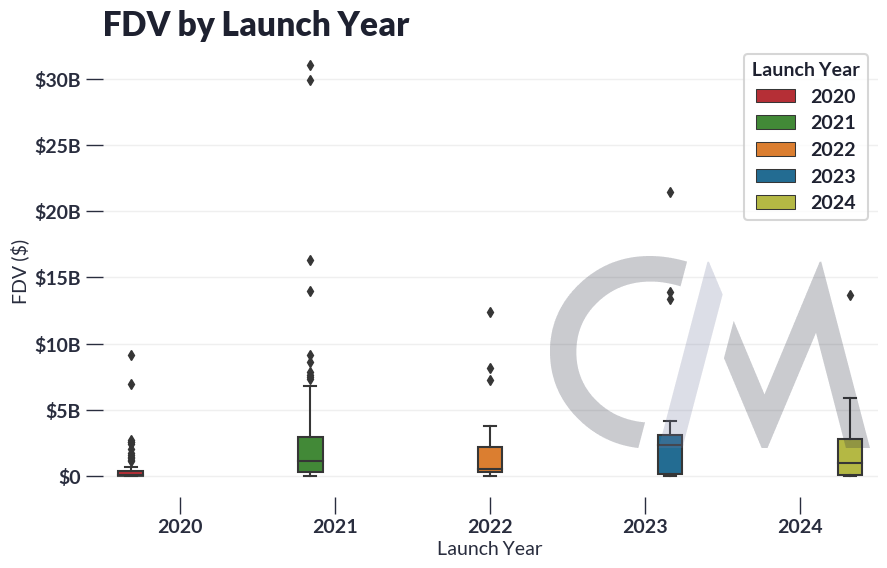
Source: Coin Metrics Market Data Feed , Network Data Pro
The median FDV of major tokens issued in 2020 was relatively low ($140M) compared to later projects, but included blue-chip protocols born out of the DeFi summer such as Uniswap, Aave, and notable L1s such as Solana and Avalanche. In 2021, the median FDV issued jumped to $1.4B, primarily including NFT and gaming projects such as Gods Unchained, Yield Guild Games, and Flow. In 2022, FDV issued declined, led by the launch of Apecoin and early L2 tokens like Optimism. In 2023 and 2024, FDV issued rebounded to $2.4B and $1B, respectively, including a new wave of alt L1s like Aptos and Sui and the rise of Solana projects like Jupiter and Jito.
Not all FDVs are created equal
While FDV can be used to measure long-term value, it does not take into account short-term market dynamics that can arise from liquidity and supply shocks. Therefore, it is important to consider the circulating supply of FDV, or the supply available to the public.
Tokens with high circulation relative to total supply, such as Bitcoin, are quite liquid, and market participants do not expect future supply shocks from token issuance — since over 90% of Bitcoin has already been mined. Tokens with low circulation relative to total supply mean that much of their FDV is illiquid. Therefore, tokens with high FDV and low circulation may represent inflated and false total valuations. An extreme example of a high FDV and low circulation token is World Coin, which has a market cap of ~$800M but a FDV of ~$34B — a 50x difference.
In general, we see the industry standard of unlocking around 5-15% of the token supply to the community, with the remainder locked to the team, investors, foundations, grants, or other unlocking events. Projects launched before 2022 tend to have a more diverse distribution.
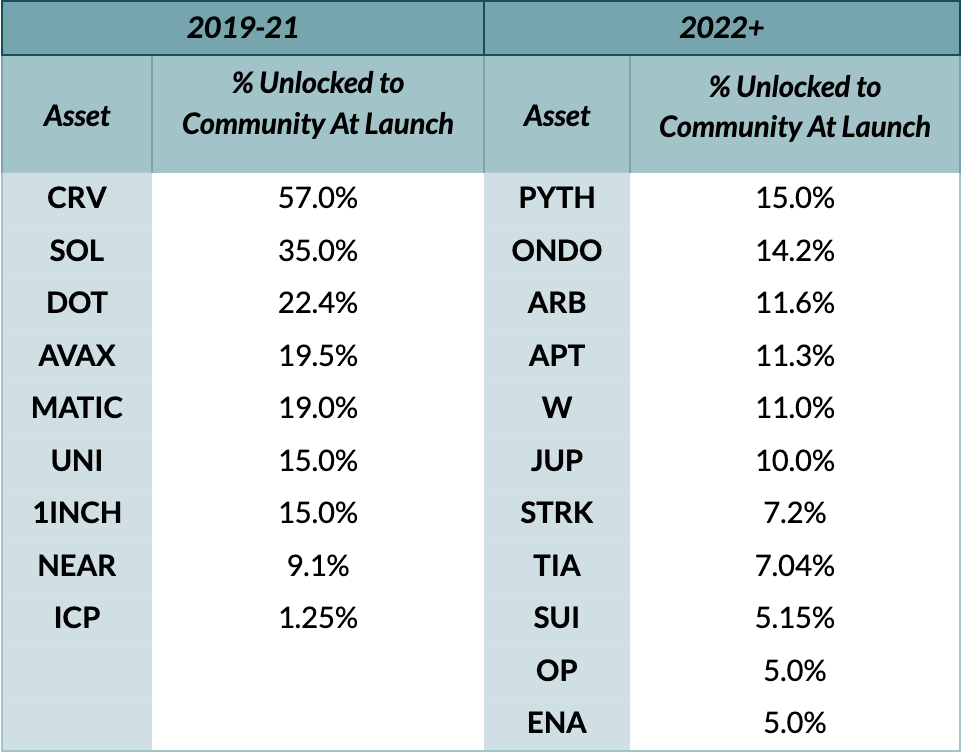
Source: Coin Metrics Labs
Tokens with high FDV and low circulation have always been the object of disdain in the crypto community. A historical example is FTX's token FTT, which inflated its balance sheet by counting its illiquid shares as assets to offset its liabilities. Token projects launched with high FDV and low circulation have been criticized as tools to enrich early investors and other insiders at the expense of retail investors. This can cause market sentiment to turn nihilistic, leading to a large influx of retail liquidity into memecoins , which tend to offer a larger share of their supply to the public in the early stages.
But is the low number of shares outstanding the only reason for the lackluster price action?
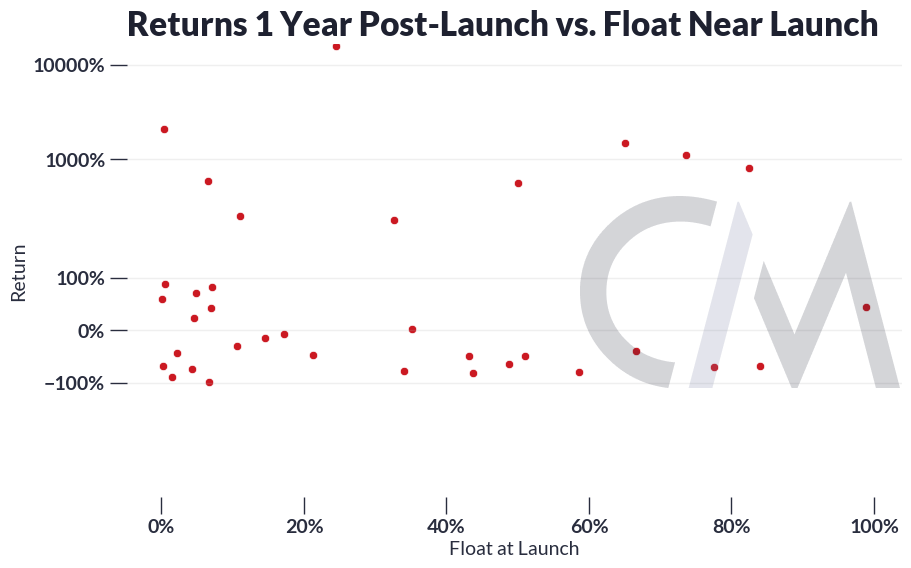
Source: Coin Metrics Market Data Feed , Network Data Pro
We find that, in general, the amount of circulation at issuance has no significant effect on the token appreciation 1 year after issuance. This is fairly consistent with our previous findings , which suggest that sudden shocks to circulation do not have a consistent directional impact on price.
Airdrops and Protocol Activities
Some protocols use airdrops to distribute tokens to the community and reduce the risk of low circulation. Airdrops reward early users of a protocol by providing them with tokens based on certain desired behaviors that promote the development of the protocol, similar to crypto stimulus checks for early users. In previous SOTN, we found that most addresses liquidated airdropped tokens shortly after receiving them.
While airdrops can bring lucrative windfalls, most airdropped tokens lose their long-term value.
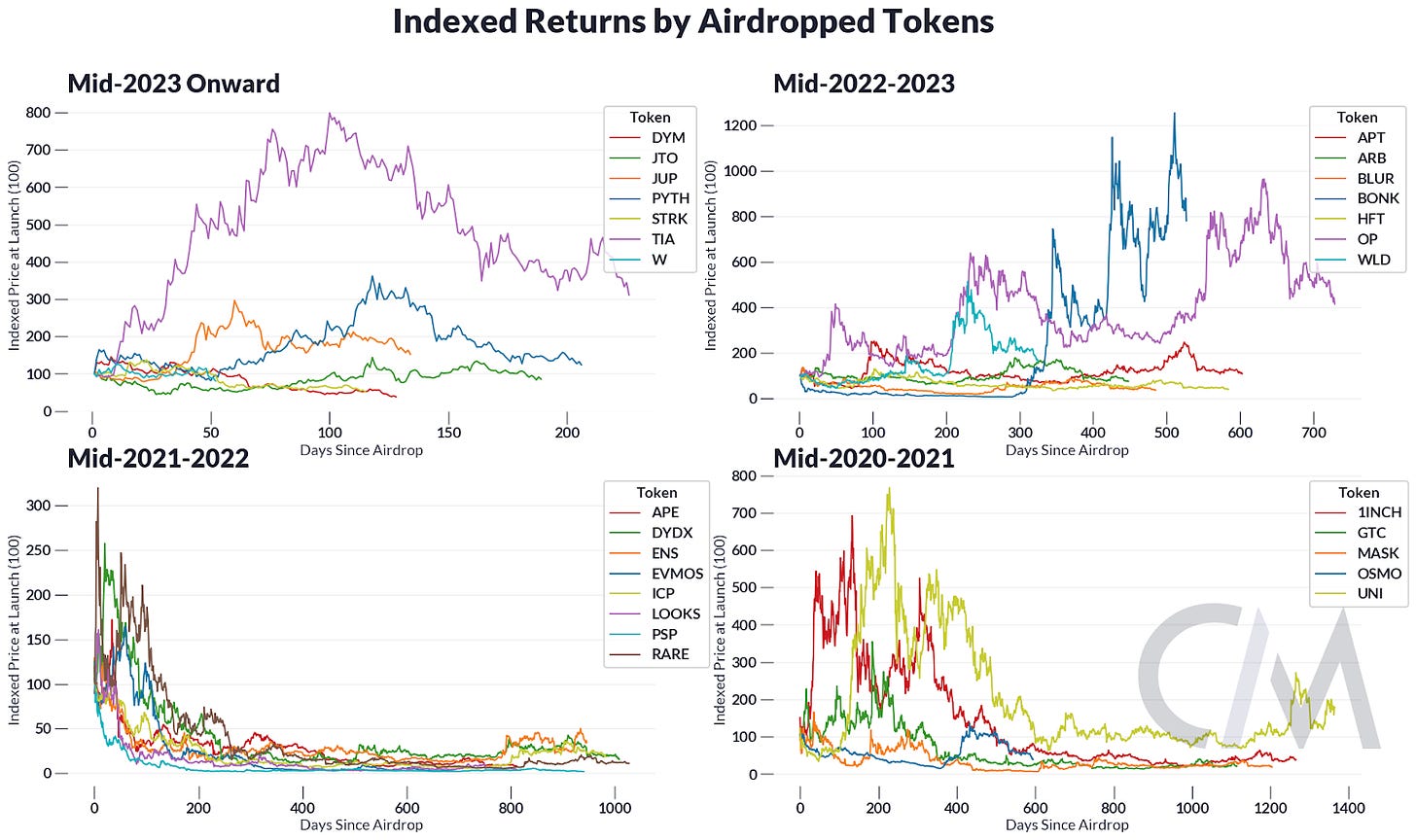
Source: Coin Metrics Market Data
Taking the first day of trading after the airdrop as a reference point, only about 1/3 of the tokens have maintained their value since the first airdrop. The average return of holding airdropped tokens to date is -61%. However, some airdropped tokens have appreciated, such as BONK (about 8 times).
Token rewards are ultimately just a way to bootstrap network activity, but do they actually lead to actual usage? Measuring actual economic activity can be tricky, as each protocol has different uses and metrics for measuring those uses. As an illustrative example, we can take Optimism (a layer 2 project) and use the amount of money deposited into the network as a rough proxy for user activity.
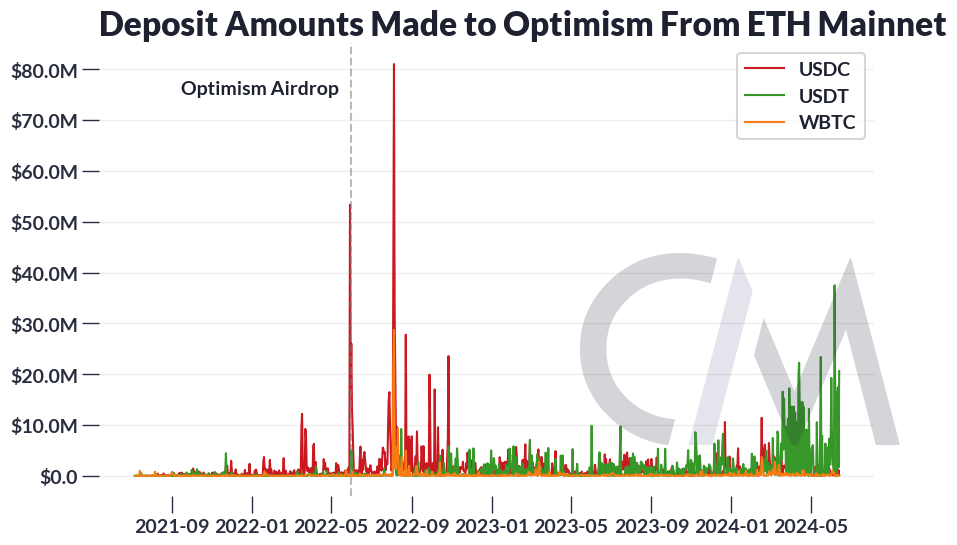
Source: Coin Metrics’ Network Data Pro , Coin Metrics Labs
After the airdrop, we saw a surge in Optimism’s Gateway Bridge deposit requests. The following year, activity tapered off, coinciding with the general decline in crypto activity. In short, the airdrop may boost usage of the protocol in the short term, but whether it can create real, sustainable long-term growth remains to be seen.
While the hint of an airdrop can incentivize early adoption of a protocol, it does not necessarily lead to sustained user activity. This is further complicated by the emergence of airdrop farming, a way for users to gamify the rules of a protocol by generating excess activity on-chain in the hope of earning tokens. Recently, airdrop farming has become increasingly industrialized with witch farms, where a small number of actors forge multiple on-chain identities to generate activity at scale. This has led to project teams handing out rewards to mercenaries who have no long-term vested interest in the network.
Protocol teams have begun to fight back against sybils by developing methods to identify and block sybils’ rewards. Notably, LayerZero is offering sybils to self-identify in exchange for a small portion of their allocation, but with the possibility of not receiving any tokens. With large-scale airdrops coming up for both EigenLayer and LayerZero, it remains to be seen whether the airdrops will achieve the desired results, or whether the projects will cancel them entirely.
in conclusion
In many ways, cryptocurrencies expose the motivations of every market participant. Token economics can be seen as the art of leveraging these motivations to foster the success and sustainability of a protocol. Allocating token supply, incentivizing behavior, and ensuring long-term value is a delicate balance that each project approaches differently. It will be interesting to see how users and teams continue to adapt as market forces evolve and new coins emerge.
Network Data Insights
Summary Key Points

The number of Bitcoin daily active addresses rose 3% this week, while the number of Ethereum daily active addresses rose 7%.
Coin Metrics Update
This week’s update from the Coin Metrics team:
- Extended support for Solana tokens: https://coinmetrics.io/coin-metrics-extends-support-for-solana-tokens/
- Follow Coin Metrics’ State of the Market newsletter, which covers the week’s crypto market moves with concise commentary, rich visuals, and timely data.
Subscriptions and Back Issues
As always, if you have any feedback or requests, please let us know here .
Coin Metrics’ Network State is an objective, weekly look at the crypto markets based on our own network (on-chain) and market data.
If you would like to receive State of the Network in your inbox, please subscribe here. You can view past issues of State of the Network here .






